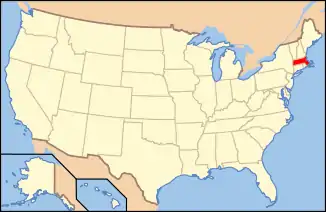Burial Hill | |
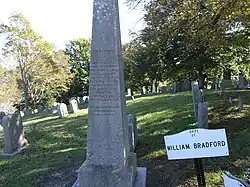 William Bradford's monument | |
  | |
| Location | School Street, Plymouth, Massachusetts |
|---|---|
| Coordinates | 41°57′22″N 70°39′58″W / 41.95611°N 70.66611°W |
| Built | 1620 |
| NRHP reference No. | 13000582 |
| Added to NRHP | August 7, 2013[1] |
Burial Hill is a historic cemetery or burying ground on School Street in Plymouth, Massachusetts. Established in the 17th century, it is the burial site of several Pilgrims, the founding settlers of Plymouth Colony. It was listed on the National Register of Historic Places in 2013.[1]
Description
Burial Hill is located just west of Plymouth's Main Street, which parallels the shoreline of Plymouth Bay, and is at the southwest end of Leyden Street, which parallels Town Brook to the south, and was the first street laid out when the Plymouth Colony was founded in 1620. The hill rises 165 feet (50 m) above sea level, and provides commanding views over the surrounding landscape and coastline. The main entrance to the cemetery is just north of the First Parish Church in Plymouth, whose current building is the fifth to stand on the same site. A network of paved footpaths are laid out through the cemetery's 5.1 acres (2.1 ha), with stairs located along steeper sections. There are more than 2,000 marked graves, dating from 1680 to 1957.[2]
History

The first Pilgrim burial ground was on nearby Cole's Hill in 1620-21.[3] Originally, the Pilgrims constructed a fort on top of Burial Hill in 1621-22 (a reconstruction exists in nearby Plimoth Plantation).[4] The Burial Hill fort also served as a meeting house for the colony and for the First Parish Church until 1677.[4] According to tradition, the first grave on Burial Hill was Pilgrim John Howland's.[5] However, he did not die until 1672; other people claimed to be buried there died considerably earlier.[6]
First Parish's congregation currently meets in an 1899 church building at the base of Burial Hill on the town square, near where it first met in 1621.[7]
Notable burials and cenotaphs
- Mary Allerton, Pilgrim, last surviving Mayflower passenger
- William Bradford, Pilgrim, Governor
- William Brewster, church elder
- Thomas Cushman, Ruling Elder of the Plymouth Colony, 1649-1691
- Robert Cushman, organizer of the Mayflower expedition (cenotaph at Cushman Monument)
- Edward Doty, Mayflower passenger
- Francis Cooke, Pilgrim, Mayflower passenger
- John Howland, Pilgrim, Mayflower passenger
- Adoniram Judson, Christian missionary to Asia
- Thomas Prence, Colonial Governor
- Thomas Russell, judge, collector of customs, and ambassador
- Zabdiel Sampson, Congressman
- James Warren, Patriot leader
- Mercy Otis Warren, author
- Richard Warren, Pilgrim, Mayflower passenger
- Squanto Native American Friend of The Pilgrims
Image gallery
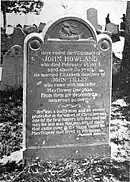 John Howland's grave
John Howland's grave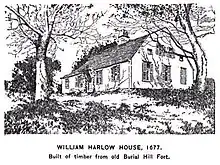 Harlow Old Fort House in Plymouth made of timbers from the Burial Hill Fort
Harlow Old Fort House in Plymouth made of timbers from the Burial Hill Fort Burial Hill Fort, housed the original church in Plymouth
Burial Hill Fort, housed the original church in Plymouth First Parish Church in Plymouth (now Unitarian Universalist) at the base of Burial Hill, is a continuation of the original Pilgrim church
First Parish Church in Plymouth (now Unitarian Universalist) at the base of Burial Hill, is a continuation of the original Pilgrim church
 Site of 1621 First Fort and Meeting House on Burial Hill
Site of 1621 First Fort and Meeting House on Burial Hill Burial Hill, cemetery entrance
Burial Hill, cemetery entrance recreation of original Burial Hill fort/meeting house at Plimoth Plantation
recreation of original Burial Hill fort/meeting house at Plimoth Plantation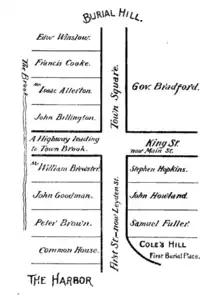 Map of early Plymouth home lots
Map of early Plymouth home lots Powder House, 2015
Powder House, 2015 Edward Gray Grave, 2015
Edward Gray Grave, 2015 Memorial to the children of John and Elizabeth Howland, 2015
Memorial to the children of John and Elizabeth Howland, 2015 William Crowe Grave, 2015
William Crowe Grave, 2015
See also
References
- 1 2 "National Register Information System". National Register of Historic Places. National Park Service. April 15, 2008.
- ↑ "NRHP nomination for Burial Hill". Commonwealth of Massachusetts. Retrieved November 20, 2017.
- ↑ Frank Herman Perkins, Handbook of old Burial Hill, Plymouth, Massachusetts: Its history, its famous dead, and its quaint epitaphs (A.S. Burbank, 1896), pg. 11
- 1 2 Frank Herman Perkins, Handbook of old Burial Hill, Plymouth, Massachusetts: Its history, its famous dead, and its quaint epitaphs (A.S. Burbank, 1896), pg. 8-10
- ↑ Frank Herman Perkins, Handbook of old Burial Hill, Plymouth, Massachusetts: Its history, its famous dead, and its quaint epitaphs (A.S. Burbank, 1896), pg. 13
- ↑ E.g., Squanto.
- ↑ Frank Herman Perkins, Handbook of old Burial Hill, Plymouth, Massachusetts: Its history, its famous dead, and its quaint epitaphs (A.S. Burbank, 1896), pg. 7
